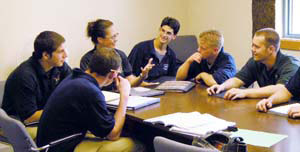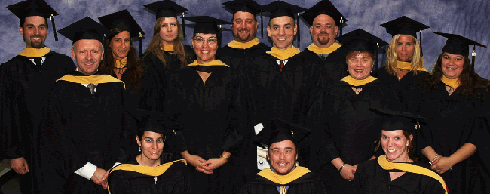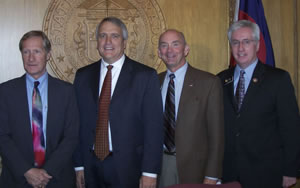News & Announcements
- Details
- Written by Joshua Wachtel
 Youth participate in a restorative circle at Lookout Mountain Youth Services Center, in Golden, Colorado, U.S.A.
Youth participate in a restorative circle at Lookout Mountain Youth Services Center, in Golden, Colorado, U.S.A.It’s no accident that Colorado is the first U.S. state to mandate that judges advise adjudicated youth of the possibility of participating in restorative justice (RJ) conferences or other programs if they become involved in the criminal justice system. (See Part 1 of this article to learn more about Colorado House Bill 08-1117, which legislated this mandate.) For more than 10 years, Colorado communities, schools, nonprofits, RJ advocates, probation, police and human service departments, courts, youth rehabilitation facilities, universities and governments have been promoting restorative justice and restorative practices (RP).
At Lookout Mountain Youth Service Center, in Golden, Colorado, the state’s oldest and largest rehabilitation facility for male youth offenders, RJ and RP have had a huge effect. “The outcome was exponentially greater than anything I could have expected,” said Carel Leaf, associate director of the Division of Youth Corrections (DYC), former Lookout Mountain director. “We started calling ourselves a community. That language gives such a different impact. We started asking youth, ‘How do you live in a community? What are your personal responsibilities and accountability?’”
- Details
- Written by Laura Mirsky
 The IIRP Graduate School class of 2008On June 21, 2008, the International Institute for Restorative Practices (IIRP) Graduate School held its first commencement ceremony, in Bethlehem, Pennsylvania, USA, conferring 14 master’s degrees: five in Restorative Practices and Education and nine in Restorative Practices and Youth Counseling.
The IIRP Graduate School class of 2008On June 21, 2008, the International Institute for Restorative Practices (IIRP) Graduate School held its first commencement ceremony, in Bethlehem, Pennsylvania, USA, conferring 14 master’s degrees: five in Restorative Practices and Education and nine in Restorative Practices and Youth Counseling.
The IIRP Graduate School received its charter to confer master’s degrees and a certificate in restorative practices from the Pennsylvania Department of Education in June 2006. Classes began that August, and 160 students have enrolled since then. The IIRP’s mission statement asserts that the institute is “dedicated to the advanced education of professionals at the graduate level and to the conduct of research that can develop the growing field of restorative practices, with the goal of positively influencing human behavior and strengthening civil society throughout the world.”
- Details
- Written by Paul McCold
Click here to view the original findings for 1999-2001.
Click here to view the the second study, with findings for 2001-2003
This paper reports on the latest (third) phase of an ongoing study, in progress since 1999, which highlights decreases in offending among 3,928 youth discharged from Community Service Foundation and Buxmont Academy's (CSF Buxmont's) restorative programs. The results of all three studies show a dramatic decline in offending rates, achieved through the systematic use of restorative practices, which diminishes only modestly over time.
CSF Buxmont Client Population
A total of 2,151 students were discharged from CSF Buxmont programs during the three school years ending in August 2004, 2005 and 2006. Students were referred from schools (SC), children and youth services (C&Y) and juvenile probation (JP). Characteristics of these CSF Buxmont clients by the referral source are shown in Table 1 *Most (68%) are boys, but a majority of youth referred from C&Y are girls (56%). Overall, most referred youth are white (74%), but a large proportion of C&Y referrals are black (27%) or Hispanic (14%).
- Details
- Written by Joshua Wachtel
 (L-R) Colorado youth RJ bill author Pete Lee, Governor Bill Ritter, Representative Michael Merrifield and Senator John Morse, at the bill-signing ceremony
(L-R) Colorado youth RJ bill author Pete Lee, Governor Bill Ritter, Representative Michael Merrifield and Senator John Morse, at the bill-signing ceremonyOn March 31, 2008, Colorado Governor Bill Ritter signed into law House Bill 08-1117, which authorizes the use of restorative justice (RJ) in the state’s Children’s Code and gives Colorado the legislative edge among states that sanction the use of RJ. The bill passed 63-1 in the House and 33-0 in the Senate.
Upon signing the bill, Governor Ritter said, “By making juvenile offenders take responsibility for the consequences of their actions, we can teach them that the decisions they make, both good and bad, will affect the course of their life. Repairing the harm that someone has caused can be the thing that matters most in the criminal justice system.” Added Ritter, “As a former prosecutor, I’ve seen too many people start out committing minor crimes as juveniles and escalate to committing serious crimes as adults. We must do everything we can to intervene early and break this cycle.”
The law, sponsored by State Representative Michael Merrifield in the House and by State Senator John Morse in the Senate, gives judges the authority to offer accused young offenders the legal option to voluntarily participate in RJ processes. The law encodes a well-defined definition of restorative justice and practices:
- Details
- Written by Brenda Lange
Matt sat quietly in the small conference room, recounting a recent experience that was a watershed in his young life. Matt has attended the Community Service Foundation/Buxmont Academy (CSF Buxmont) school, in Trevose, Pennsylvania, USA, since October 2006, where emphasis on community problem-solving and support was key to his handling of this very challenging situation and his subsequent personal growth.
 Dave provides support for his friend and fellow-CSF Buxmont student, Matt.“I’ve been through some hard times,” the 18-year-old began. “I’ve been arrested for possession of marijuana, and I was taking OxyContin [a prescription narcotic pain medication] for a year and a half. I finally realized that I have a family that cares and I went into outpatient [treatment], then inpatient, and I’ve been clean since.”
Dave provides support for his friend and fellow-CSF Buxmont student, Matt.“I’ve been through some hard times,” the 18-year-old began. “I’ve been arrested for possession of marijuana, and I was taking OxyContin [a prescription narcotic pain medication] for a year and a half. I finally realized that I have a family that cares and I went into outpatient [treatment], then inpatient, and I’ve been clean since.”
A shadow crossed Matt’s face as he talked about last month’s traumatic incident, when his 30-year-old brother’s liver was failing from alcohol abuse. He wasn’t expected to live; in fact, he was given last rites. “I was there, and it scared the hell out of me,” said Matt.
- Details
- Written by Joshua Wachtel
 Ping Yi Secondary School students participate in a restorative circle.In 2005, Ping Yi Secondary School in Singapore was chosen by the Ministry of Education as one of four pilot schools to receive training and begin using restorative practices (RP). The school is now entering its fourth year of the pilot and is working to train teachers and administrators to use RP reactively in cases of discipline, but also proactively to create a restorative school culture.
Ping Yi Secondary School students participate in a restorative circle.In 2005, Ping Yi Secondary School in Singapore was chosen by the Ministry of Education as one of four pilot schools to receive training and begin using restorative practices (RP). The school is now entering its fourth year of the pilot and is working to train teachers and administrators to use RP reactively in cases of discipline, but also proactively to create a restorative school culture.
Singapore is a prosperous industrial nation and center of trade for south Asia. The city sports beautiful high-rise office buildings as well as successful factories. The small island country about the size of Chicago (one of the few city-states in the modern world) has a population of over four million and sits just off the coast of Malaysia a few short miles north of the equator. The population is comprised of about 75 percent Chinese, 14 percent Malays, 9 percent Indians, and the rest Eurasians and other groups.
- Details
- Written by IIRP
The show presents views from criminologists Lawrence Sherman, Kathleen Daly andChris Cunneen, and CEO of the Centre for Restorative Justice, SouthAustralia, Leigh Garrett.
- Details
- Written by Laura Mirsky
[The goals and philosophy of restorative practices are, of course, consistent with those of programs promoting social and emotional learning. These findings should therefore buoy the confidence of those working in schools to enhance social and emotional learning by means of restorative practices.]
The study showed that students who participate in school-based programs that focus on social and emotional learning, compared to students who do not, improve significantly in terms of social and emotional skills; attitudes about themselves, others and school; social and classroom behavior; emotional distress such as stress, anxiety and depression; achievement test scores (11 percentage points higher); and school grades.
- Details
- Written by Lynn M. Welden
This article by Lynn M. Welden talks about how restorative practices is spreading in schools throughout New South Wales and South Australia, aided by multi-school summits or forums, where staff meet to share their implementation experiences.
- Details
- Written by Lynn M. Welden
 West Beach Public School pupils and teacher Rosemary Griffin participate in SW Metro District’s Restorative Directions Day, engaging in a circle process.Two Australian educators are making an important difference in the emotional and academic vitality of the schools in their regions. Lyn Doppler has been principal of the award-winning Rozelle Public School in Sydney, New South Wales, since 2002. Lesley Oliver is manager of Student Inclusion and Wellbeing for the government of South Australia’s Department of Education and Children’s Services (DECS), representing the South West (SW) Metro District of Adelaide. Each has been recognized for her leadership role in embedding restorative practices in Australian schools.
West Beach Public School pupils and teacher Rosemary Griffin participate in SW Metro District’s Restorative Directions Day, engaging in a circle process.Two Australian educators are making an important difference in the emotional and academic vitality of the schools in their regions. Lyn Doppler has been principal of the award-winning Rozelle Public School in Sydney, New South Wales, since 2002. Lesley Oliver is manager of Student Inclusion and Wellbeing for the government of South Australia’s Department of Education and Children’s Services (DECS), representing the South West (SW) Metro District of Adelaide. Each has been recognized for her leadership role in embedding restorative practices in Australian schools.
Restorative practices (RP) in schools is based on the principles of restorative justice. Police officer Terry O’Connell was one of the restorative justice pioneers in Australia in the early 1990s. Currently director of Real Justice Australia (an affiliate of the International Institute for Restorative Practices), Terry O’Connell found that bringing offenders and victims and their supporters together in a face-to-face meeting had a beneficial effect on the healing process. His “scripted model,” used in facilitating such restorative conferences, has had enormous impact on criminal justice throughout the world.

Restorative Works Year in Review 2023 (PDF)
All our donors are acknowledged annually in Restorative Works.
